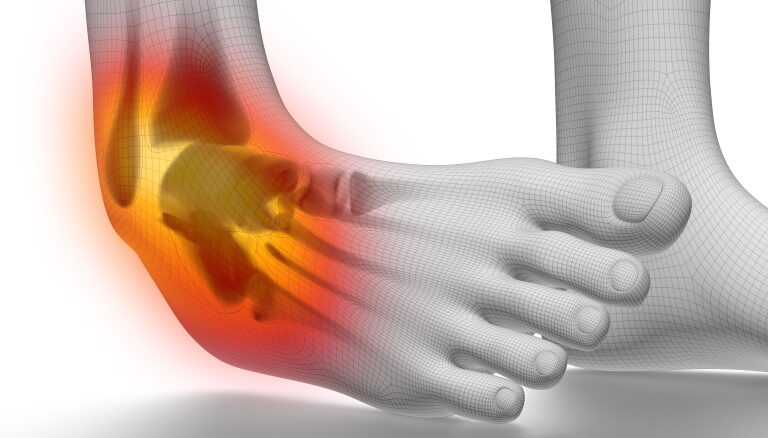A lateral ligament ankle sprain occurs when the ligaments outside the ankle are stretched beyond their limits. Injury to these ligaments causes pain and swelling in the ankle. Generally, most sprained lateral ligaments are minor and will improve with simple treatments. However, severe cases can weaken the ankle, leading to repeated lateral ligament sprains and chronic pain. So, how do you diagnose a tear of the ankle ligaments, and what do you do? Is a cortisone shot for an ankle sprain an option?
What are the lateral ligaments?
Ligaments are strong fibrous structures that connect bones. For example, three ligaments connect the top and bottom of the ankle joint on the outside of the ankle. Spraining the ankle damages one or more of these lateral ligaments.
Causes
A Lateral ligament ankle sprain occurs when the ankle rolls inwards or twists. Your ankle twists while playing sports involving a change of direction or an unexpected fall.
Usually, the more times you sprain your ankle, the more likely you’ll sprain it again.
Clinical findings of a lateral ligament ankle sprain
A sprained lateral ligament of the ankle generally causes pain outside the ankle. Other symptoms include:
- A pop or crack sound at the time of the injury
- Swelling, which forms immediately or overnight
- Bruising
- Stiffness due to inflammation, which is worse in the morning and improves with activity
- Instability of the ankle joint – This may occur with complete tearing of the ligaments.
- Tenderness at the ligaments
Usually, your doctor will diagnose a lateral ligament ankle sprain by carefully examining the ankle and foot. As a rule, you must ensure you don’t have a break (fracture) or cartilage injury. An X-ray, ultrasound, or MRI is often needed to confirm a lateral ligament tear and rule out other injuries.
Treatment of a sprained lateral ligament of ankle

Almost all pulled ligaments in the ankle can be treated without surgery. Even complete lateral ligament tears get better with treatment such as bracing and physiotherapy. Just because you tore your ligaments doesn’t mean you need surgery.
In general, we suggest a three-phase process to get you back to sport:
- Phase 1 includes rest from sport, compression, and regular icing to limit swelling. A short course of ibuprofen can help. Also, a small cast boot may provide extra support.
- Phase 2 includes range-of-motion exercises, stretching, and calf strengthening. Balance exercises are also essential to prevent a recurrence.
- Phase 3 involves complex exercises, a gradual return to running, and a change of direction activity. Your therapist will introduce agility drills to test the ankle.
Ankle sprain getting worse and not better: What to do
About 10% of lateral ligament sprains do not improve with simple treatments. In these cases, seeing your doctor and exploring imaging to confirm the diagnosis may be helpful. Generally, we need an ultrasound or MRI to diagnose other problems, such as a peroneal tendon tear or ankle cartilage damage.
Examples of other damage to the ankle include:
- breaks in the small bones of the ankle, such as the anterior process of calcaneus, the base of the 5th metatarsus, or os trigonum
- cartilage damage in the ankle joint
- tears of tendons, such as peroneal tendons
- damage to other joints, such as the subtalar joint, or a high ankle sprain.
Cortisone shot for ankle sprain: Is it an option?
Every so often, an injection is helpful for therapy. For example, persistent inflammation in the ankle joint is a common cause of ankle pain after a rolled ankle. A cortisone injection directed at this inflammation can reduce pain and allow for more rehab.
Generally, we perform injections with ultrasound to improve accuracy. A small needle is inserted into the area of inflammation, and ultrasound allows us to avoid essential nerves and blood vessels.
Occasionally, surgery is needed to remove the inflammation or reconstruct the ligaments. We typically refer to surgery for cases that fail rehab.
Commonly asked questions about lateral ligament ankle sprains:
Why do I keep twisting my ankles?
Generally, repeated ankle twists lead to more damage to the outside ligaments, meaning you’re more likely to twist again. Therefore, we stress the importance of seeing a therapist after a sprain to prevent future sprains.
Why won’t my ankle heal after a sprain?
Not all sprained ankles involve just ligament damage. Sometimes, rolling your ankle can damage other structures, such as tendons or cartilage. In these cases, we recommend you see an experienced doctor who can identify why you have ongoing ankle problems.
Can torn ankle ligaments heal without surgery?
Yes. Even in tears of all the ligaments outside the ankle, the ankle can regain full function without surgery. We suggest a short rest period in a walking boot followed by slow physiotherapy.
Deltoid ligament sprain: Do we treat it differently?
The deltoid ligament inside the ankle is much larger and more robust than the lateral ligaments. Therefore, a tear of the deltoid ligaments is a more severe injury requiring extended rehab. In complete tears of the deltoid ligament, we recommend a surgical repair.
Cortisone shot for ankle sprain: When should I do it?
Generally, we suggest a cortisone shot for an ankle sprain that fails to settle with physiotherapy. A cortisone shot effectively reduces persistent swelling after an ankle sprain. We usually suggest considering a cortisone shot if you fail to improve with rehab for 3-6 months after an ankle sprain.
Final word from Sportdoctorlondon about lateral ligament ankle sprains
Not all ankle injuries are benign and settle with physiotherapy. You should see an expert sports doctor to diagnose and manage your problematic ankles correctly.



Is below knee back slab recommended for lateral co-lateral ligament injury in young adults in ankle?
Hi Shiva, it depends on the severity of the lateral ligament injury. Generally, I recommend a CAM walker boot rather than a plaster for high grade tears, but you should speak to your doctor. https://sportdoctorlondon.com/transition-from-walking-boot-to-shoe/
Regards
Lorenzo